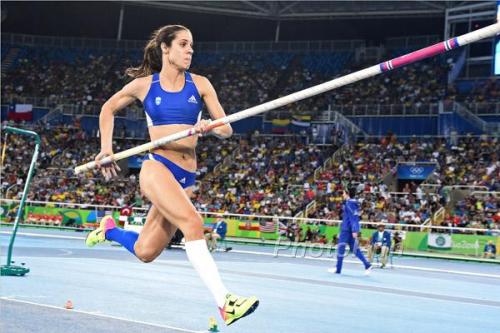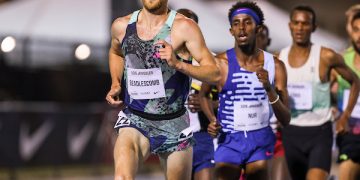Watching Ekaterina Stefanidi develop as an athlete has been fascinating. Getting updates from her manager, Karen Locke, is always fun. For the European and Olympic champion, Ekaterina Stefanidi’s overnight success has taken her around the world, since, at the young age of ten, she began vaulting.
Read this fine piece by our friend, David Hunter, who is still sleeping a bit after a long day in the office at the Boston Marathon, while he helped me with our live coverage for 8 hours, and provided RunBlogRun two features on the elite marathons. And, 256,000 of you watched and read our coverage, thanks!
Pass this one around, it is another good one from Dave Hunter!
 Ekaterina Stefanidi, photo by PhotoRun.net
Ekaterina Stefanidi, photo by PhotoRun.net
March 26th, 2017
A successful track & field athlete needs several critical traits: natural talent; a disciplined work ethic; a reliable support system; knowledgeable coaching; an unflappable demeanor; an unshakeable focus; and – among the most important – an engrained sense of motivation which inspires the athlete to employ all of those other characteristics in the quest to achieve the targeted track & field goal. A survey of the current marquee track & field athletes suggests that Ekaterina Stefanidi, reigning Olympic and Diamond League pole vault champion, is among those few athletes who receive high marks in virtually all of these categories – especially motivation.
Stefanidi – who likes to go by Katerina – was born and raised in Greece by parents who themselves have tasted track & field success. “Both my parents competed for the national team in Greece. My mom ran the 400 meters and my dad competed in the triple jump,” the Nike athlete explains. “Neither of them competed in the world championships, but we have smaller championships in which they competed. And that’s how they met each other.” While only Greek was spoken in her home, Katerina – a gifted student – began learning English at an early age. “English is the language we learned in school – starting in the 3rd grade.” The young grade schooler began vaulting at age 10 and five years later she cleared 4.30m/14’1¼” to win the gold medal at the 2005 IAAF World Youth Championships.
Stefanidi’s emerging vault success combined with her growing proficiency in the classroom and with her English encouraged the young field star and her parents to begin thinking about the viability of an American university experience for her. “I knew what Harvard was. I had heard of Yale and Princeton. But I had never heard of Stanford,” she explains. “When we received the letter [expressing serious interest] from Harvard, my dad said, ‘Let’s pack your bags.’ And I said, ‘I’m sure there is a process to this,’ laughs Katerina. “We found a guy to help me out with the SAT’s and the application process. He said, ‘We’re going to look at Stanford because they have a very good track program and they are just as good academically.’ So that’s how we found out about Stanford – he was the one who suggested it.” Katerina knew that earning admission to one of the most respected and prestigious universities in the world would not be easy. But she was motivated. Aided by her college advisor, Katerina took a “gap year” to polish her English in preparation for taking the SAT Examination – in a language foreign to her. A solid score on the standardized test – the last piece of the puzzle – when combined with her vault prowess and classroom skills paved the way for her entry into the west coast university.
At Palo Alto, Katerina soon learned that further honing her vaulting skills while at the same time meeting the rigorous academic demands required at Stanford necessitated more than simply commitment and aptitude. She had to become a masterful multi-tasker. Her busy upbringing prepared her well. “Growing up we had to drive a long way to go to [track & field] practice. So what I would do is come back from school at 2:00 p.m. and have lunch. Around 3 p.m., my dad and I would leave to go to practice. We would normally come back at 8 or 9 p.m. and have dinner,” explained the Stanford biology major. “I would have only an hour or so a day to study. So I would learn that when I have this hour, I would actually need to be studying this entire hour. I learned to focus very well,” she reveals. “And that made things pretty easy. I learned that this is study time and in 60 minutes I can be done if I do it right.” It proved to be a focusing skill she could turn on and off in the world of academia – and also on the vault runway.
Stefanidi produced storybook pole vault progression while at Stanford. The 6-time All-American [“If that counts for me,” laughs the Greek athlete.] won the PAC conference vault championships her final three years of collegiate eligibility. At the national level, she climbed progressively higher on the NCAA pole vault medal stand: 5th indoors and 4th outdoors as a sophomore; 2nd indoors and 3rd outdoors as a junior; and 3rd indoors and – finally! – 1st outdoors in 2012 to cap off her decorated collegiate career. During her four years at Stanford, Stefanidi upped her game – improving her vault PR by over 10 inches to 4.51m/14’9½”.
Not unlike other athletes, Stefanidi found that the transition from accomplished collegiate track & field performer to successful professional is a sometimes-challenging process that takes time. With vault marks that easily qualified her for Greece’s national team, the new pro was suddenly off to the 2012 Olympic Games. In London, the young vaulter only cleared 4.25m/13’11¼” to finish 14th in the qualifying round, unable to advance to the final. Nagging injuries knocked her out of the 2013 season. At the 2015 World Championships, Stefanidi performed better: clearing 4.45m/14’7¼” to finishing 9th in the qualifying round, just missing the cut to the final.
Last year, the Greek star got it all together: earning a global medal at Portland’s World Indoors, jumping 4.80m/15’9″ to snag bronze behind two Americans, gold medalist Jenn Suhr and silver medalist Sandi Morris; dominating the Diamond League by amassing enough points to clinch the overall vault title even before the climactic final gathering; and winning Olympic gold in Rio by exhibiting focus and poise to prevail in a dramatic three-way battle over Morris and New Zealand’s Eliza McCartney. The Olympic final in the women’s vault was a tense contest. With 6 athletes over at 4.70m/15’5″, clean jumpers Stefanidi and McCartney were tied for the lead, with Morris in 3rd. At 4.80m/15’9″, the Kiwi’s first-attempt success gave her the sole lead when Stefanidi and Morris required second-attempt clearances. Only Stefanidi and Morris cleared 4.85m/15’11” – both on their second attempts – putting the Greek star in the lead with Morris in 2nd. At 4.90m/16’¾, the remaining pair could produce no clean jumps in first two rounds. And when the Greek, first in the jump order, missed her final attempt, Stefanidi who – like the legendary Valery Brumel – purposely does not watch her competitors jump, had to sweat out Morris’ final attempt to snatch the gold. “I went over to Mitchell [her husband/coach] and he handed me the flag. We knew I was at least the silver medalist. I would have been happy [with the silver medal]. I didn’t watch [Sandi’s final attempt]. I have been in that situation many times before.” And when Morris’ thigh brush spoiled her valiant final attempt, the gold medal for Stefanidi was secured.
Like the Suhr’s, Katerina and her husband Mitchell Krier share both a husband/wife and coach/athlete relationship. And Mitchell provides a summarizing insight on their championship mindset. “The strategy is more that everybody to goes to a major championship and they are so worried about making the finals that they act like this is something they haven’t done,” he explains. “Our whole idea at Europeans and Worlds is you’ve jumped this way the whole time and we have to go in like this is a meet you want to jump 16 feet. If you come in here at 14’3”, that’s 3 extra jumps. So you’re not preparing to try to jump high; you’re preparing to be 6th. So we said we’re not going to do that. We’re going to jump as we do every meet and treat these championships like the meet you want to jump high.”
Like her husband and coach, Stefanidi sees herself – as well as other women – jumping high in the years ahead. “Height-wise, I think women can jump close to 5.20 [17’¾”]. I think that would be somewhere where women will go soon,” projects the 26-year-old Olympic champion. “I think I am somebody who can jump close to that. I don’t want to come out and say I’m going to jump 5.20. I think women will eventually jump 5.20. Soon enough all the medals will be over 5 meters. We had it at 4.60, now we have it at 4.80. It has gone up 8 inches. It will soon go to 5 meters. When we you have 5-6 women jumping 5 meters and even attempting 5.10 or even higher, somebody will jump [5.20m]. I hope to be one of the women in that group. I am relatively young for the event. Most people PR after 30. If we keep doing what we are doing, stay healthy, keep improving, just doing what we are doing every year, things will come – even 5.20.”
The reigning Diamond League champion is looking forward to the 2017 DL global competition. But she has reservations about the series’ new format which will pit the top 8 point-getters in a star-studded, winner-take-all final in the late-summer climactic gatherings. “It is going to be interesting for multiple reasons because somebody like me and Sandi and Jenn, we can be training hard and still jump high enough – even though we are tired – to make enough points to make it into the finals,” notes Stefanidi. “I could finish 4th in the Diamond League meets and gather enough points to get into the finals and theoretically win the finals which is the most important meet. But I don’t know what that would do for the year end rankings. It changes he season very much.”
Stefanidi can’t hide her pique when reflecting on last year’s world rankings “I won the Diamond League, the European Championships, and the Olympics and wasn’t ranked #1,” exclaims the Greek vault star in reference to Track & Field News listing her #2 behind American Sandi Morris whose 5.00m/16’4¾ at the DL final in Brussels was last year’s outdoor world leader. Possible source of motivation for the coming year? “Maybe, just a little bit,” concedes Stefanidi, #3 on the 2016 outdoor world list and #7 all-time outdoors. “I am not somebody who cares about rankings too much,” she explains. “Because I won an Olympic gold medal and I have it home now,” she adds with a laugh.
Stefanidi knows how important motivation is and she has definite views about it. “I think a lot of people try to find motivation through something that didn’t quite go as they wanted. And it is good to find a positive in something like that and motivate yourself,” she states. “But I think you also can find motivation in success. I won the Olympics and it makes me want to do better. That’s what motivates me. Success is a much better and happier motivator.”
Stefanidi is coming off a successful – and thus by her standards a motivating – indoor season which featured her making the two highest indoor clearances of year in capturing the European Indoor Championship vault crown [4.85m/15’11”] and an important Millrose Games victory [4.82/15’9¾”] over her rival Morris. Only months have passed since her Olympic triumph, yet the champion is already looking ahead, thinking about the Tokyo Games, and contemplating the legacy she would like to leave. “I think winning another Olympic medal makes you something special. Winning once is great – you’re a champion at something,” she declares. “Winning twice makes it a little different now. You’re dominating a certain number of years in an event. I don’t want to be motivated by my medals, but [winning medals] is more important to me. Eventually people remember people who won the medals more than people who jumped high twice a year. I think that is a big motivation for me.
As Katerina Stefanidi demonstrated last summer at the Rio Games, the Greek vaulter has the ability to draw upon that burning motivation to activate all of her other critical strengths at just the right time to produce that magnificent gold medal performance. It is interesting to learn what provides motivation for this world class athlete. But what’s really important, of course, is that she has it.
Author

Dave Hunter is an award-winning journalist who is a U.S. Correspondent for Track & Field News. He also writes a weekly column and serves as Senior Writer for www.RunBlogRun.com, and covers championship track & field competition domestically and in such global capitals as Moscow, Birmingham, Zurich, Brussels, Beijing, Rio de Janeiro, Zagreb, Ostrava, and Doha. Hunter frequently serves as the arena or stadium announcer for championship track & field gatherings, including the Ivy League, the Big East, the Mid-American Conference, the NAIA, the Big Ten, and the Millrose Games. Hunter has undertaken foreign and domestic broadcast assignments. He ran his marathon P.R. 2:31:40 on the Boston Marathon course back in the Paleozoic Era. To find out more about Dave, visit his website: www.trackandfieldhunter.com He can be reached at: dave@trackandfieldhunter.com
View all posts




















